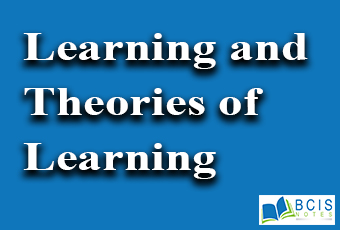
Learning and Theories of Learning
Theories of Learning are an organized set of principles explaining how individuals acquire, retain, and recall knowledge. They are categorized into two parts:
- Stimulus-Response Theory(Behaviorism)
- The Cognitive Theory
Stimulus-Response Theory:
Stimulus-Response (S-R) relationship also called a behavioral theory, interprets learning as an associative process where learning is a new association or connection that is formed between a stimulus and response.
This group of learning supported by:
- Pavlov’s classical conditioning
- Thorndike’s trial and error
- Skinner’s operant conditioning
- Hull’s reinforcement theory
- Guthrie’s contiguity theory
A. Pavlov’s classical conditioning:
Russian psychologist is known for his discovery of classical conditioning in psychology. During his studies on the digestive system, he won the Nobel Prize in 1904. Pavlov proved that animals salivated naturally upon the presentation of food. He was remembered for his theories of learning by conditioning.
Classical Conditioning:
Conditioning is the process of learning associations, by linking two events that occur together, usually between a stimulus and a response or between two stimuli. A basic form of learning in which one stimulus comes to serve as a signal for the occurrence of a second stimulus is known as classical conditioning.
Basic Elements and Pavlov used certain terms in his theory:
- Unconditioned Stimulus(UCS): The meat powder was the unconditioned stimulus.
- Unconditioned Response(UCR): The salivation in response to food in the dog’s mouth.
- Neutral Stimuli (NS): the sound of bell, light, etc
- Conditioned Stimulus: Neutral stimulus acquires the ability to elicit salivation response after being paired with an unconditioned stimulus. NS with the UCS (food ) changed into conditioned stimulus (CS)
- Conditioned Response (CR): Salivation in response to the CS (light, bell) is known as the conditioned response (CR).
Classical Conditioning:
Ivan Pavlov (1927) in his studies fed meat power (UCS) to the dog while a bell (CS) was ringing. The meat power caused the dog to begin salivating (UCR).
The several presentations of CS followed by Us and strengthening of the behavior were termed as reinforcement by Pavlov. After several-reinforcement when the sound of the bell alone was presented, the dog salivated (CR). The classical conditioning phenomena had been established.
Conditioning Processes: Basic principles
- Acquisition
- Extinction
- Spontaneous recovery
- Generalization
- Discrimination
1. Acquisition:
- It is the training stage during which the animal is learning the stimulus-response relationship.
2. Extinction:
- If the conditioned stimulus (CS) is presented alone a number of times without the food, the magnitude of the conditioned response (CR) of salivation begins to decrease.
- This process with the gradual disappearance of the conditioned response (CR) on disconnecting the S-R association is called extinction.
3. Spontaneous recovery:
- Spontaneous recovery refers to the sudden resurfacing of a conditioned response, which was previously extinguished due to a lack of association between a conditioned and unconditioned stimulus.
4. Stimulus generalization:
- The tendency of stimuli similar to a conditioned stimulus (CS) to evoke a conditioned response (CR) is called stimulus generalization.
5. Stimulus discrimination:
- The process by which organisms learn to respond to certain stimuli but not to others.
Applications of Classical conditioning:
- Treatment of a behavior problem
- Treatment of phobias
- Learning taste (Aversion and Preparedness)
- Study of sensory capacity
You may also like Operant Conditioning.

Leave a Reply